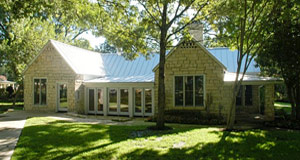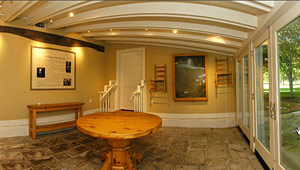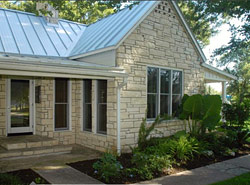 If these walls could talk...
If these walls could talk...
The land that is now Block House MUD had previously been part of Blockhouse Fort, built in 1838 by the Republic of Texas. The fort consisted of a cedar blockhouse and stockade built around a spring and big lookout tree, and was manned by rangers. A blockhouse is defined as a strong wooden fort with a projecting second story and openings in the walls for defenders to shoot from. At the time, the only timber was along the banks of small creeks leaving a clear view of the horizon. Rangers perched in the treetop watched the surrounding countryside for far-off dust clouds that meant raiders were coming, and settlers could bring their families, cattle and possessions into the fort for protection. However, the fort was burned in 1839 by Indians and never rebuilt.
 Alexander Stuart (A.S.) Walker came to Texas from Virginia by way of Indiana. His father practiced law with David G. Burnet, the old Texas revolutionary and J. Pinckney Henderson, the first governor of Texas.
Alexander Stuart (A.S.) Walker came to Texas from Virginia by way of Indiana. His father practiced law with David G. Burnet, the old Texas revolutionary and J. Pinckney Henderson, the first governor of Texas.
A. S. Walker moved to Georgetown in 1853 and was named district clerk and district attorney. He was elected district judge in 1862, while serving in the Confederate Army. After the Civil War, the U.S. Army removed him from office. Late in 1865, Alexander Stuart Walker, Jr. was born. Soon after the Civil War, Judge A. S. Walker acquired possession of the Block House land in payment for legal services.
A. S. Walker returned to Austin and launched a newspaper called The Democratic Statesman and served as its first editor-in-chief. He practiced law with Alexander W. Terrell, a war hero and populist activist. Later, Terrell would become ambassador to Turkey and state senator, authorizing legislation to construct the state capitol. Terrell County in West Texas is named in his honor. Walker served as a district judge and Texas Supreme Court justice. He died in 1896.
 The younger Walker attended Southwestern University and Washington & Lee, and returned to Austin to become one of UT’s first law students. After graduation in 1886, he joined the law practice with Terrell and T.W. Gregory. Gregory was a lifelong supporter of the University of Texas, and he’s the namesake of Gregory Gym. Gregory later served as attorney general in President Woodrow Wilson’s cabinet.
The younger Walker attended Southwestern University and Washington & Lee, and returned to Austin to become one of UT’s first law students. After graduation in 1886, he joined the law practice with Terrell and T.W. Gregory. Gregory was a lifelong supporter of the University of Texas, and he’s the namesake of Gregory Gym. Gregory later served as attorney general in President Woodrow Wilson’s cabinet.
A.S. Walker Jr. became county attorney and was twice elected county judge in Travis County. In 1900, he returned to Williamson County, to his ranch that is now Block House MUD and lived in the Walker House we know today. He returned to public life in 1913 when President Wilson named him collector of Internal Revenue for the district that included Texas. He and his wife Katherine (the daughter of UT president Dr. Leslie Waggener) had two children. His daughter Frances was Phi Beta Kappa at UT but died at the age of 24, just a few weeks after her father assumed his internal revenue duties. A son, also known as A.S. Walker Jr. was in charge of the family’s Williamson County land until he became an officer in World War I.





